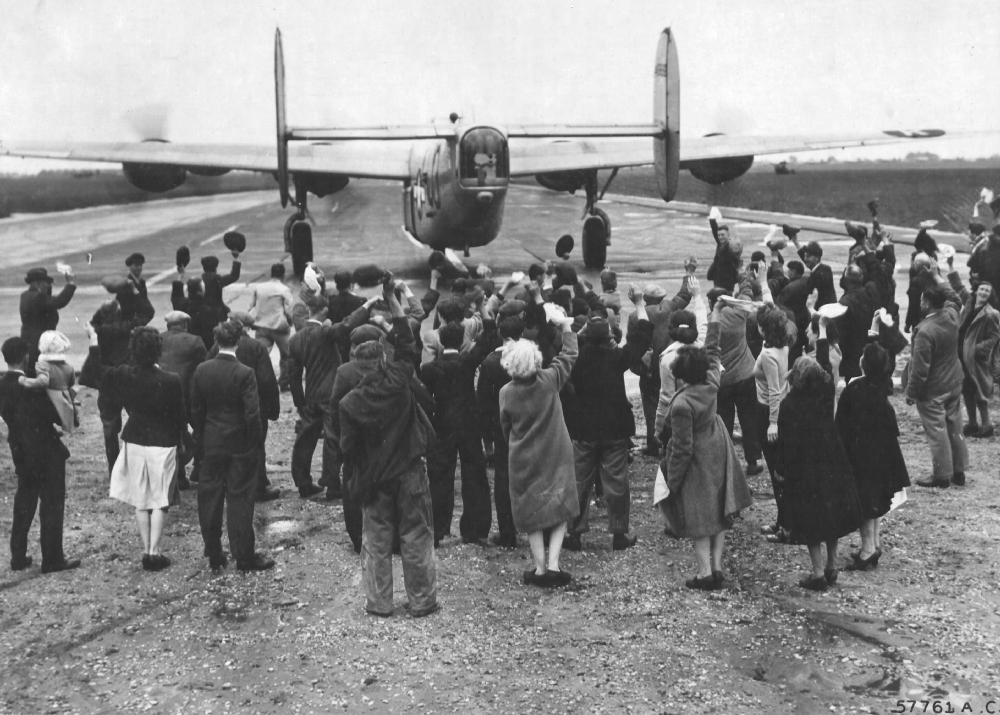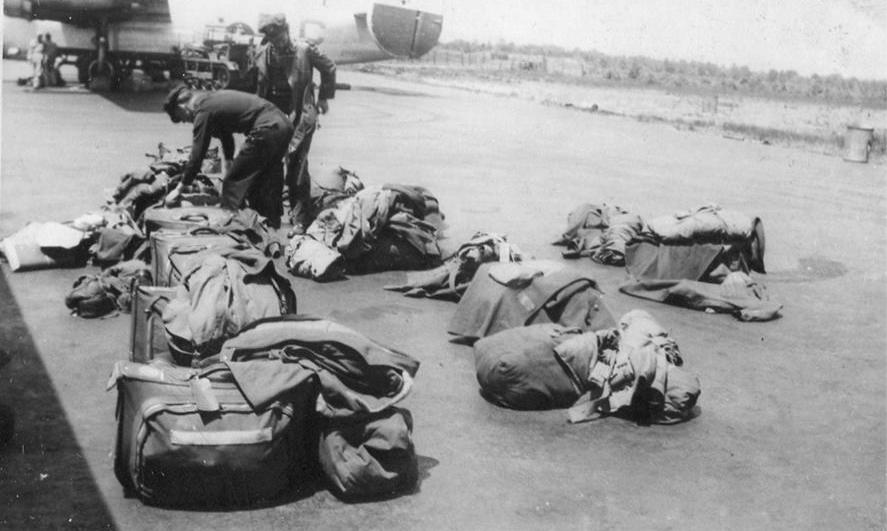458th Bombardment Group (H)
Group History
June – September 1945
458TH BOMBARDMENT GROUP (H)
HISTORY
SUMMARY OF OPERATIONS

The Last Liberator: American air crews of the U.S. 8th A.F. get a send-off from their English hosts of almost three years. Men and women of a small British town near the air base really felt the definite end of the war with Germany, seeing these airmen who had waged the air battle from their soil for so many months, leave in their Consolidated B-24 Liberator. [Pictured is a late-model B-24 from the 755BS (J3) leaving Horsham’s runway for the last time.]
The Air Echelon was alerted for movement to the Zone of Interior and full preparations were underway to make the move on schedule. All crews were being qualified for over water flying in accordance with ATC standards, and the aircraft were modified to merit the same standards.
During this time the following Promotions were announced:
MAJOR JOSEPH HALL, Ground Executive Officer, to Lt. Col.
CAPTAIN SAMUEL M. LAKIN, S-4, to Major
1ST LT. GORDON S. JONES, Photo Officer, to Capt.
The Bronze Star was awarded to Lt. Col Joseph Hall and Col. Allen F. Herzberg.
On 14 June the Air Echelon departed England with stop overs at Azores and Ireland, and landed at Bradley Field, Connecticut without loss of aircraft. It was necessary to leave Lt. Col. Wilkenson in the Azores as he developed pneumonia.
20 June the Ground Echelon was alerted for movement and preparations began immediately for clearance of Station 123. All property was turned in. The personnel were given a show down inspection, and last minute farewells were made to the many friends in England.

3 July the Ground Echelon departed for the POE and the next day boarded the Queen Mary. The ship left port on 6 July and after an uneventful voyage, docked at New York on 11 July. All personnel proceeded to Camp Kilmer N.J. and from there were given 30 days for rest and recuperation.
12 July an advance party proceeded to Sioux Falls AAF, South Dakota. All personnel eventually returned and were transferred to other organizations, finally depleting the personnel completely.
The Group records were transferred to Walker Field, Kansas on 25 July and immediately personnel began to join. 13 August, Capt. Patrick Hays was assigned to the Group and assumed command. Four days later, 17 August, Major Bernard Carlos took command.
About 20% of the authorized strength was assigned the group. And on 21 August they proceeded by air to March Field, California.
22 August Major V.R. Woodward [right] assumed command of the Group. Major Woodward was the only man in the organization that had been with the unit in the E.T.O. [He had been, in fact, a member of the 458th, pilot on Crew 41, since training at Tonopah in the fall of 1943.]
The following were assigned and assumed command of Squadrons as indicated:
Major Frank, 752 Squadron
Major O’Neill, 753 Squadron
Major Feldman, 755 Squadron
Capt. Hays took command of the 754th Squadron and Maj. Haveman was assigned as Group Operations Officer. The Squadron Orderly Rooms were set up, and as personnel were assigned, they were further assigned to the Squadrons. 66 fully trained crews were assigned and practically all personnel were behind in flying time. A temporary program was put into effect to keep everyone occupied, consisting mainly of physical education.
1 September an extensive training program was inaugurated, consisting of refresher course, and continuation training. The use of 4 A/C, B-29, were obtained from the base, and each Squadron had the use of these A/C every fourth day.

3 September Lt. Col. Wilmer C. Hardesty assumed command of the Group.
The Group, since being reorganized upon its return from the E.T.O. was never up to full strength. At no time was the strength above 60% of the authorized strength. A large number of personnel in the MOS’s essential for the proper operation of the Group were not assigned, and much difficulty was encountered in that regard. Anyone who had the barest knowledge of a typewriter was employed as a clerk, as there was no personnel with the proper MOS (405) in the Group. Improvised personnel made up the Officers and EM pay vouchers and pay rolls, and some men were receiving payment.
The Group operated only one mess hall for the EM which was not satisfactory, due to the inability of the kitchen to handle such a large number of personnel. The kitchen was just not large enough to take care of so many men without a long waiting line around the mess hall. Everyone, regardless of MOS, from the rank of Buck Sgt. down had to take a turn at K.P., causing some griping, but on the whole, causing no lowering of morale.
About 12 September, word was received that the Group would be deactivated very shortly. The majority of the crews were transferred to other Groups, as were many of the ground personnel. Large shipments were being made up almost daily, and simultaneously all personnel, both Officers and EM, were screened regarding their age, length of service, adjusted service rating, etc. This greatly overtaxed the administration personnel, but the work did progress well.
15 September the Group participated in a parade and review with all Base Personnel, and received a commendation, as the Group made an excellent showing, tying for first place.
